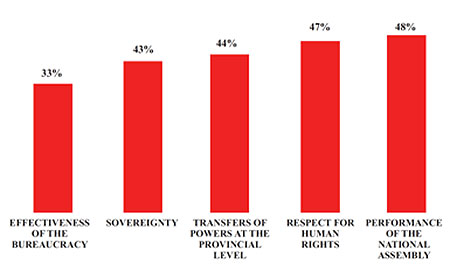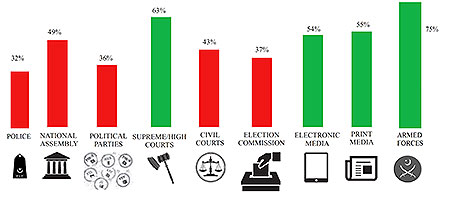-
Only
30% of the respondents believe the General Election 2013 to be somewhat
to completely rigged at the end of the 2nd year, compared to 37% in the
1st year
-
51%
of the respondents rate highly the current Government�s performance in ensuring
democratic oversight of the security sector
-
PML-N
garners highest Approval Rating, with 70% of the respondents rating the
party�s competence highly; Approval Ratings of PTI and PPP at 44% and 36%
respectively
-
Prime
Minister Nawaz Sharif remains the most trusted leader with an Approval Rating
of 75%; Mr. Imran Khan garners an Approval Rating of 49%, while Mr. Asif
Ali Zardari of 27%
-
The
Armed Forces most trusted institution with an Approval Rating of 75%, while
Police the least trusted with an Approval Rating of 32%
October 19; At the completion of the second year of the current Parliament and
Provincial Assemblies, 66% of the respondents approve of the Overall Quality
of Democracy in Pakistan.
These public views are part of a Nationwide Public Opinion Poll by PILDAT on
assessing citizens� views on Quality of Democracy in Pakistan at the end of
the 2nd year of the current Federal and Provincial Legislatures elected after
General Election 2013. 1
On 11 core indicators measuring quality of democracy in Pakistan, 6 show positive
approval rating while 5 are rated negatively. Respondents have given above 50%
approval rating to Independence of Media (64%), Effectiveness of Supreme
Court (56%), Trust in Favourite Political Party (56%), Performance of Independent
Cabinet (52%), and Democratic Oversight of Security Sector (51%). Approval
Ratings for these 11 core democracy indicators for both the surveys conducted
at the end of the 1st and 2nd year of the Government can be seen in Table 1.
Table 1: Comparison of Approval Ratings at the Completion of the 1st
and 2nd Year of the Elected Parliament & Provincial Assemblies

Figure
1: High Scoring Core Democracy Indicators: Approval Ratings 2015

Figure
2: Low Scoring Core Democracy Indicators: Approval Ratings 2015

59%
of the respondents believe that the General Election in 2013 was somewhat to
completely transparent and fair. On the contrast 30% respondents see the Election
as somewhat to completely rigged. For the democracy survey conducted at the
end of the 1st year of the elected Governments, 53% of the respondents believed
that General Election 2013 were completely to somewhat transparent and fair
and 37% thought they were somewhat to completely rigged.
Performance of Major Political Parties
Signifying
decreasing support with Pakistan�s political parties, 56% of the respondents
stated that they retain �Very High� to �High� level of trust in their favourite
political party at the end of the 2nd year, in comparison to 64% at the end
of the 1st year. Additionally, the Approval Rating for trust in political parties
as an institution remained low, with only 36% of the respondents expressing
their approval for it.
The
Pakistan Muslim League-Nawaz (PML-N) had the highest approval amongst the population,
with 70% of the respondents rating the party�s competence highly. The Pakistan
Tehreek-e-Insaf (PTI) followed at an Approval Rating of 44% The Jamaat-e-Islami
(JI) and the Pakistan Peoples Party were approved of by 40% and 36% of the respondents
respectively.
In contrast, all other political parties included in this poll generated relatively
lower approval levels of their competence. The MQM emerged as the most negatively
rated political party in the country with an Approval Rating 14%. Dr. Tahir-ul-Qadri�s
Pakistan Awami Tehreek (PAT) received a relatively low rating at 19%, the Awami
National Party (ANP) was favourably voted for by 21% and the Jamiat Ulema-e-Islam
Fazl-ur-Rehman (JUI-F) had only slightly higher Approval Ratings at 23%.
Figure 3: Performance of Political Parties

Trust
in Leaders
A review of the current leadership of the country shows that the people of Pakistan
have contrasting views on the most trustworthy leaders in the country.
Of the political leadership in the country, Prime Minister Nawaz Sharif emerged
as the most popular political leader with an approval rating of 75%. Mr. Muhammad
Shahbaz Sharif, the Chief Minister of the Punjab is not far behind at an Approval
Rating of 72%. Mr. Imran Khan, Chairman PTI, has garnered an approval of 49%.
Other national political leaders that the poll included had relatively lower
ratings. Mr. Altaf Hussain emerged as the least popular leader in Pakistan with
an approval rating of 13%. Chaudhry Shujaat Hussain also earned substantially
lower ratings at 19 %, followed closely by Mr. Asfandyar Wali at 18%. Mr. Asif
Zardari, Co-Chairman of the PPP earned a similarly weak Approval Rating of 27%.
A comparison of Approval Ratings of national leaders, for the survey conducted
at the end of the 1st and 2nd year of the current elected Governments is given
in Figure 4.
Figure 4: Trust in Leaders

Trust
in Institutions
Respondents from across Pakistan were also asked to assert their level of approval
in terms of how democratic major national institutions were. The data presented
in Table 2 provides an indication of the most and least trusted institutions
in the country, along with providing a comparison of Approval Ratings for the
survey conducted at the end of the 1st and 2nd year of the current elected Governments.
Figure 5: Trust in Institutions: Approval Ratings 2015

Table
2: Trust in Institutions: Approval Ratings 2014 and 2015

Pakistan�s
Armed Forces are seen as the most trustworthy institution, with an approval
rating of 75%. In comparison, this Approval Rating stood at 73% by the end of
the 1st year.
Similarly, the Supreme and High Courts of Pakistan earned a strong Approval
Rating of 63% while the Print and Electronic Media also generated high Approval
Ratings of 55 % and 54% respectively. The National Assembly was characteristic
of an Approval Rating of 49%, followed by the Civil Courts (Lower Courts) at
43%. The Election Commission of Pakistan was able to earn an approval rating
of 37%.
In contrast to the robust trust in the Armed Forces and media by the people
of Pakistan, Political Parties (in contrast to the indicator of Trust in Favourite
Political Party) and the Police had lower ratings of 36% and 32 % respectively.
Local Governments
A substantial 80% of the respondents say that holding Local Government elections
nationwide are somewhat to very important. Only 11% of the respondents believe
that holding these elections is not very important or not important at all.
Public opinion in favour of holding Local Government elections has seen a clear
increase, as by the end of the 1st year of the Federal and Provincial Governments
in May 2014, this number stood at 71%, whereas 27% of the respondents believed
that holding these elections is not very important or important at all. On
the other hand, 72% of respondents believe that elected Local Governments are
somewhat to very important in solving the problems faced by Pakistani Citizens,
whereas by the end of the 1st year, only 65% of the respondents believed this
to be the case. Only 19% asserted that elected Local Governments are not important
in resolving the problems faced by citizens by the end of the 2nd year.
Approval Ratings of Various Indicators in Performance of the National
Assembly
The National Assembly received the highest rating regarding its function of
law making with 55% respondents giving a high approval rating on the issue.
In all of its other functions however, the National Assembly received low ratings.42%
gave the Assembly a high approval rating on improving relations between the
Federal Government and Opposition, 40% gave it a high approval rating on Oversight
of Government actions, and only 39% gave a high approval rating on the Prime
Minister�s attendance in the National Assembly.
Provincial
Breakdown of Quality of Democracy Indicators
With regards to the provincial breakdown of the quality of democracy indicators,
Punjab and Balochistan differ in their lowest Approval Rating of the core Quality
of Democracy Indicators. In Balochistan, the lowest
approval was registered on Respect for Human Rights (28%);
a perennial and somewhat legitimate concern of the people of Balochistan, while
in Punjab the least approval was registered on Effectiveness of the
Bureaucracy (31%).
An
important point to note here is the high Approval Rating on
Effectiveness of the Federal Cabinet (58%) recorded in Balochistan.
This score supports the idea that the people of Balochistan are increasingly
becoming more comfortable with the democratic set-up at the Federal level, and
are fully supportive of retaining a democratic political system in the country.
The
lowest approval rate in Sindh was also recorded on Effectiveness
of the Bureaucracy (32%). Moreover Safeguarding Sovereignty
of the State (36%) was rated poorly by the people of Sindh. The only
high Approval Ratings were registered on Independence
of Media (72%) and Overall Quality of Democracy (69%).
The
people of KP gave the highest approval to
Trust in Favourite Political Party (82%). This rating can be
taken as evidence for strong support for the current system of democracy, as
well as its qualitative performance over the last two years. The only low rating
from the province was recorded on Effectiveness of the Bureaucracy (44%).
Given the lower approval ratings on this indicator from all four provinces,
including Punjab, democratic governments at the centre and in provinces should
invest their focus and energies into reforming the bureaucratic institutional
infrastructure in the country.
The complete report titled Public Opinion on Quality of Democracy
in Pakistan At the End of Second Year of Federal and Provincial Governments:
June 2014-May 2015 can be accessed at: http://www.pildat.org/publications/publication/Democracy&LegStr/
PublicOpinionOnQualityofDemocracyinPakistan_October2015.pdf
(1).
The survey results are released from a two-part PILDAT survey covering separately
Quality of Governance and Quality of Democracy.
The two-part public opinion survey was first conducted by PILDAT upon the completion
of the 1st year of National and Provincial Assemblies and Governments in office
in May 2014 to gauge public opinion across the country on quality of governance
and democracy. The nationwide poll was conducted again during June 02-12,
2015 following the completion of the 2nd year of the National and Provincial
Assemblies and Governments. The respondents for the survey included
3231 citizens from rural and urban areas from all the four provinces of Pakistan.
The fieldwork for the report was done in face-to-face interviews in respondents�
homes. The sample is also based on a cross-section of various age, income, education
and language groups of the population. Error margin is estimated to be approximately
+3-5% at 95% confidence level.
|